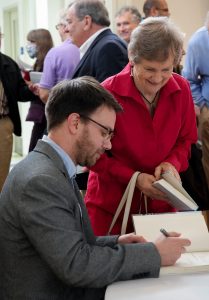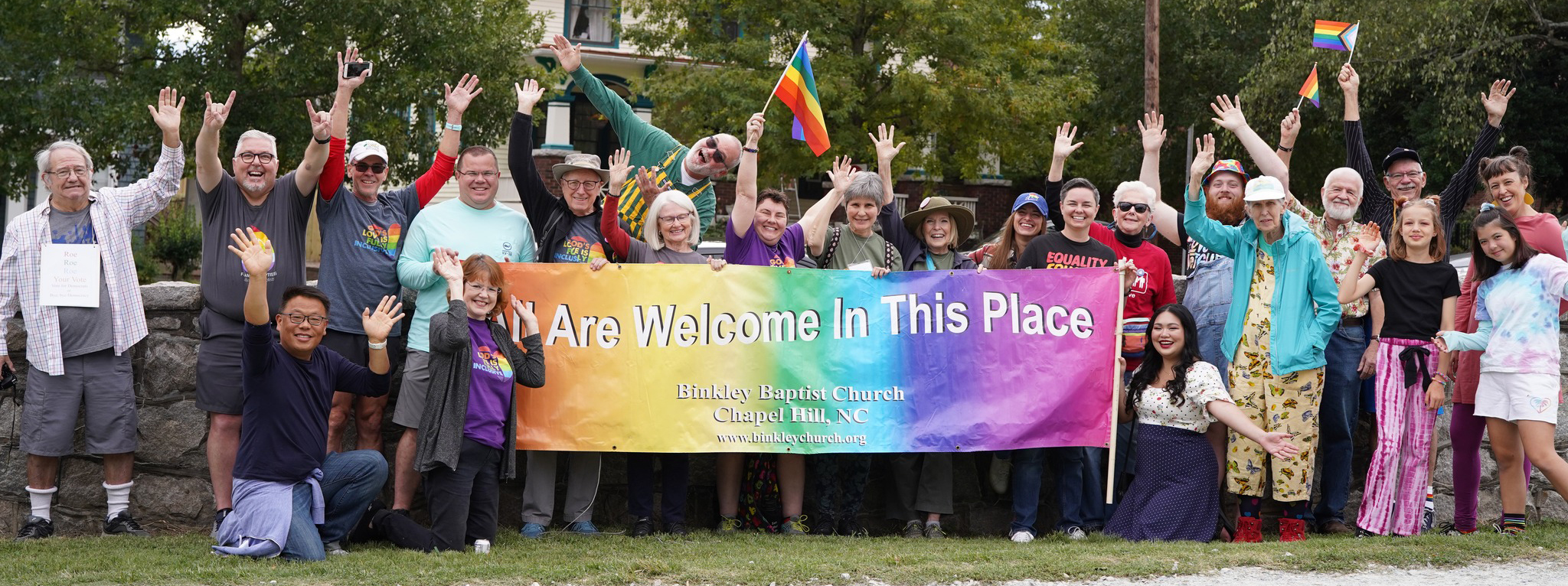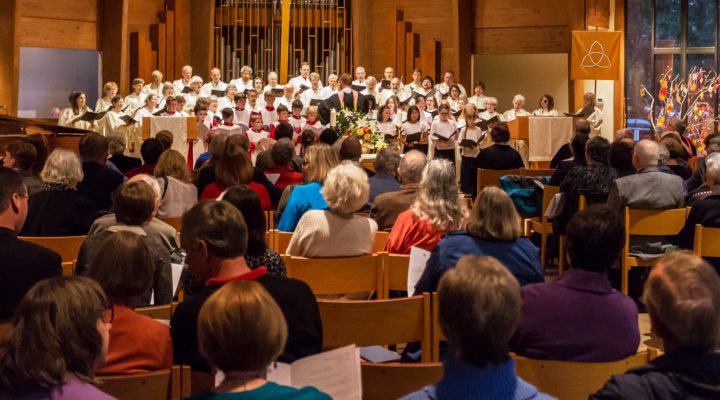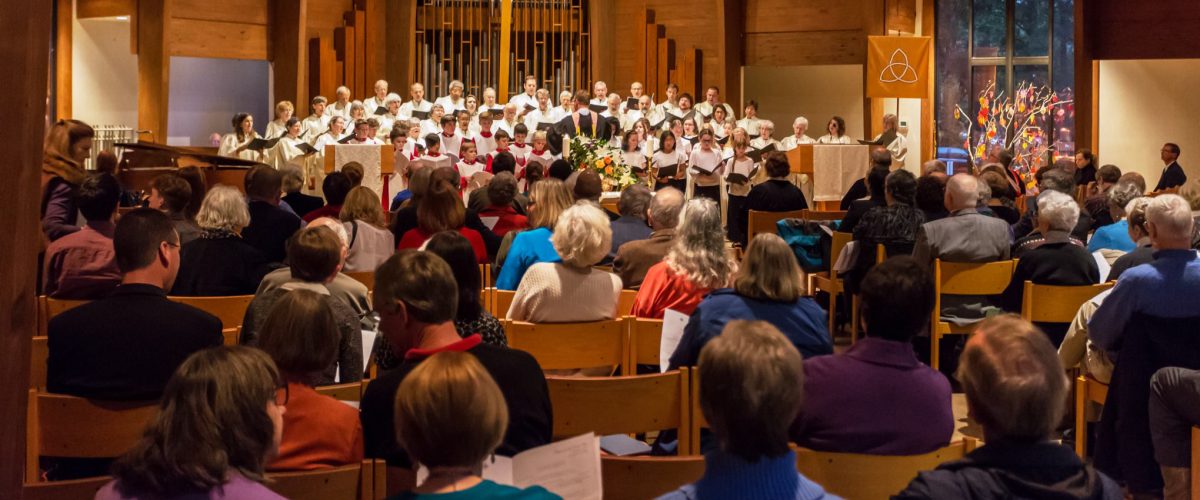The Olin T. Binkley Memorial Baptist Church didn’t want the typical chronicle or hagiography when it asked historian Andrew Gardner to write its congregational history.
“And we didn’t want a coffee table book of nice pictures,” said Senior Minister Marcus McFaul. “We wanted an examination of our history, and we got it. It’s not just accurate, it’s a fine piece of writing and a new standard of examining local church history.”
In his newly released Binkley: A Congregational History, Gardner presents an interpretive account of the Chapel Hill, N.C., church and explores the question of what makes a Baptist church Baptist.

Andrew Gardner signing books at Binkley
“Part of what I was trying to do was show how local Baptist identity really is,” said Gardner, author of Reimagining Zion: A History of the Alliance of Baptists and soon to be lecturer in religious studies at LaGrange College in Georgia. “It’s really hard for us to have national and event global definitions of ‘Baptist’ because the term encompasses so many denominations and groups. It’s hard to find meaning in the term outside of localized contexts.”
Gardner said he also wrote the history to unpack the complex, intersectional issues of race, gender and sexuality that Binkley has simultaneously contended with throughout its history. The book “looks at how they support all these different social causes and do so holistically.”
Founded in 1958 in a bustling university town, Binkley was launched from the ground up as a progressive religious institution committed to racial inclusion and Civil Rights activism. Its radical approach to social justice ministry was considered especially innovative for a Baptist church in the South, a spirit embodied in its visionary first pastor, Robert Seymour.
The setting also played a significant role in shaping the church, too, Gardner said. “Chapel Hill at the time was growing and there was an influx of people, and the church wanted to be closely related to the University of North Carolina at Chapel Hill, which was known for being a Southern progressive institution that championed academic freedom.”
Binkley’s active support of integration often has been the stuff of national headlines. During the 1960s, the church invited Black college students to become members, embraced an African American interim pastor who went on to become the first Black senior minister at Riverside Church in New York City, and celebrated as a high-profile member legendary UNC men’s basketball head coach Dean Smith.
Smith successfully integrated the team — what his pastor at the time told him was his spiritual work.
The small church went on to become a leader among Baptists in championing women in ministry and, along with Pullen Memorial Baptist Church in nearby Raleigh, was one of the first congregations booted out of the Southern Baptist Convention for welcoming LGBTQ Christians fully into the life of the church. Binkley also developed an ecumenical spirit as it aligned with the American Baptist Churches USA, the Alliance of Baptists and North Carolina Council of Churches.
The unique moral and spiritual leadership demonstrated by the congregation ties back into its context as a Baptist church in a university setting, Gardner said. “When Baptists talk about church autonomy, it’s always conceptualized as freedom from hierarchical institutions, but also as a freedom to look like your local community. To be Baptist is to be embedded in the community and, in Chapel Hill, that means you are going to have a more progressive, intellectual leaning and approach to your church.”

Marcus McFaul
McFaul praised Gardner’s book not only for its retelling of important milestones in the church’s history, but for illuminating the internal tension generated by leading in matters of race, gender and sexuality.
“Baptist life is messy. It doesn’t matter if you’re far right or at the far end of the progressive left, church life is messy because of the people and the complexity of relationships. And this history shows that,” he said.
The book also reveals the church’s willingness to have its difficulties shared with the world, McFaul said. “One of the hallmarks of Binkley is that we are not afraid of saying there was dissent and dispute. To me, it says that healthy places move toward the conflict, and you acknowledge it and you try to tease out how you can still manage that and stay a body of Christ in a place and in the world.”
Gardner highlights the conflict around the construction of the church sanctuary, the licensing of a gay Duke Divinity School student and a debate over ordaining a Black seminarian who opposed same-sex relationships. Disagreements over these and other issues often led to hurt feelings and even the loss of members. A reading of the text provides insight into issues of pastoral authority, congregational decision making and “the interplay between those poles,” McFaul said.
“By putting these controversies and conflicts in print for everyone to read, Andrew shows how the church made those decisions in these important moments in our congregation’s life. And he shows how Baptist churches, especially liberal, progressive ones, make decisions that honor a plurality of opinions and carve out room for dissent. It shows how a congregation manages and unites around things where it’s not 100%. Things are rarely 100%.”
The challenges continue for Binkley as today it confronts white supremacy and Christian nationalism and considers the ways the congregation has contributed to those ideologies, he said. “So many of our book studies have looked at how does a white, progressive church like Binkley, with a high concentration of learned folk, look in the mirror a little differently to acknowledge our own culpability and complicity in the systems that make it such that African Americans and others are oppressed.”
Binkley: A Congregational History will be used in congregational book studies and sermon series to enhance the congregation’s continuing examination of white privilege and to identify ministries around race, gender and economic justice, McFaul said. “Anytime you confront your affluence and you shine a light on it, there will be some discomfort, and if we thought we did all our Civil Rights and justice work in the ’50s and ’60s, we had another thing coming because those issues are never done completely.”
If anything, Gardner’s book also offers solace by showing Binkley can survive whatever challenges come its way, McFaul said. “The church has been able to withstand a lot of debate and dispute across 65-plus years now, and we’re still here. We are still attached to, and formed by, the church’s mission and we are trying to live out each day in our context.”



